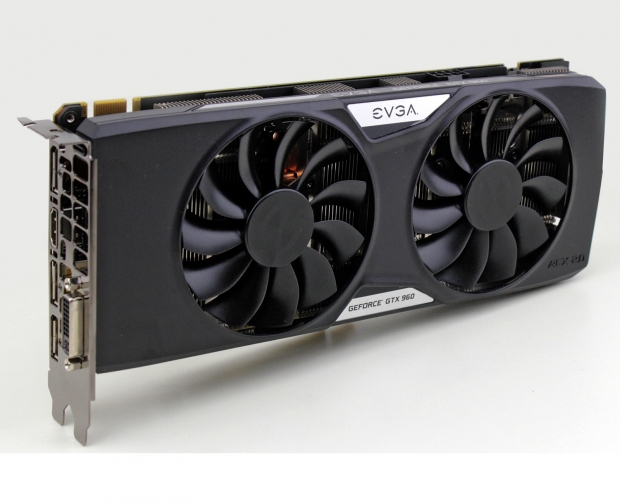Index
Review: High factory overclock and silent cooler
Nvidia’s Geforce GTX 980 and GTX 970 are extremely powerful and successful graphics cards, and now with the GTX 960 the power efficient Maxwell architecture is available to mainstream consumers.
Maxwell even made its way into the mobile Tegra X1 SoC and there is no doubt that the architecture is extremely power efficient, despite its reliance on the mature 28nm node.
Nvidia launched the Geforce GTX 960 describing it as a “sweet spot” graphics card. Traditionally Nvidia “sweet spot” cards as the 60-series models such as the GTX 460, 560, 660, 760 and so on. They tend to offer a good price/performance ratio and the current generation can run most titles at 1080p with high detail settings. The suggested MSRP for the GTX 960 is 200€.
Nvidia gave its partners the green light to launch custom GTX 960 designs from day one, so we are already seeing factory overclocked cards with custom coolers and PCBs. The GTX 960 offers AIBs a chance to show what they can do, since the card is a good overclocker, doesn’t require a lot of power and does not generate much heat.
As one of Nvidia’s premier partners, EVGA was one of the first players to launch a number of custom cards. While most AIB partners are offering one or two 960-series cards, EVGA is going a step further, or a few steps with no less than six different GTX 960 cards. Today we will take a look at one of them – the EVGA Geforce GTX 960 SuperSC ACX 2.0+ (Part Number: 02G-P4-2966-KR) with EVGA’s new dual-fan cooler.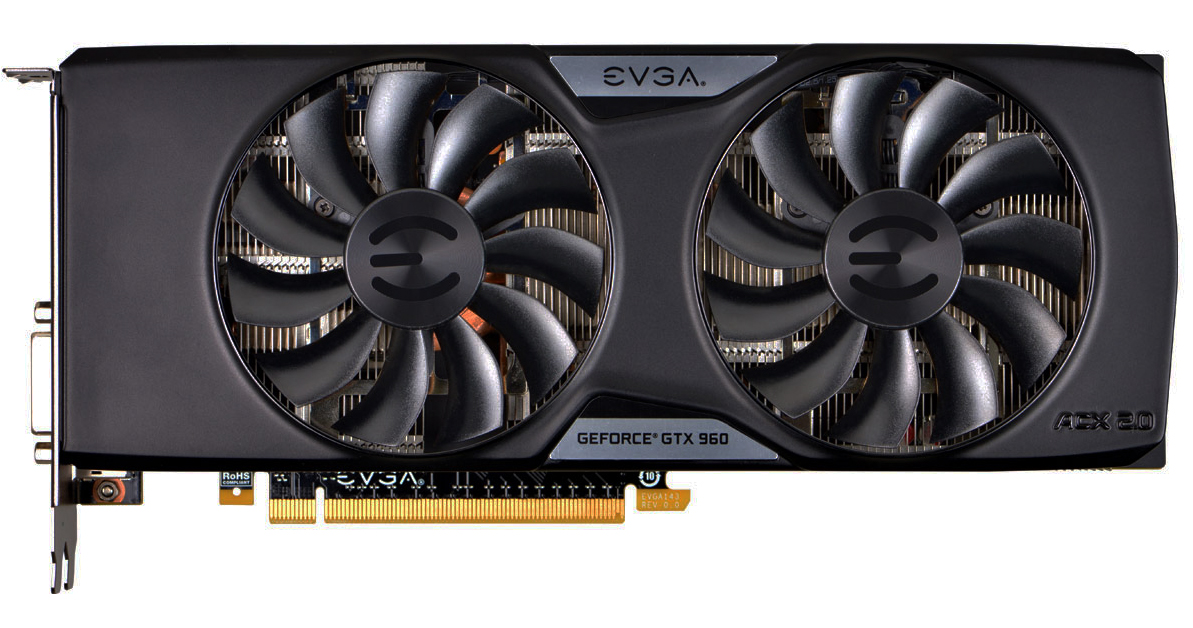
The GTX 960 SuperSC ACX 2.0+works at a base clock of 1279MHz, while the reference GPU base clock is 1126MHz. Nvidia's GPU Boost 2.0 takes the average GPU clock to 1178MHz for the reference GPU and to 1342MHz for the SuperSC card. Note that the actual Boost clock will vary on different machines and in different titles.
EVGA did not change the memory clock. The GTX 960 SuperSC ACX 2.0+features 2GB of GDDR5 memory clocked at 1752MHz (7010MHz effective), providing up to 112.16GB/sec of peak memory bandwidth.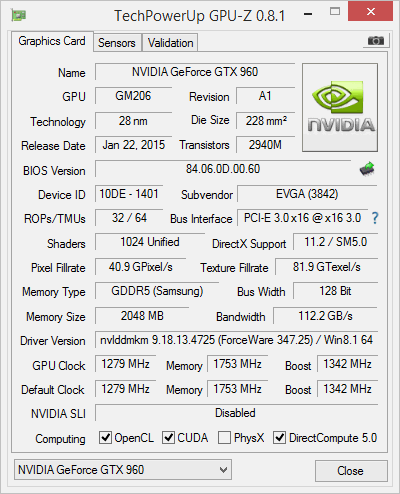
The new ACX 2.0+ cooler is supposed to ensure quiet and cool operation despite the factory overclock, but it should also provide additional overclocking headroom. One 8-pin power connector provides additional power in case the user want to overclock the GPU even further. The reference GTX 960 card uses only one 6-pin power connector.
The next photo shows EVGA’s GTX 960 line-up. The GTX 960 FTW is only 25MHz faster than the SuperSC version.

Nvidia designed Maxwell to deliver more efficiency and performance, so the GTX 980, GTX 970 and GTX 960 are vastly more efficient than their Kepler-based predecessors. The GTX 980 has a TDP of 165W, the GTX 970 is rated at 145W, while the GTX 960 has a TDP of 120W.
The old GTX 780 Ti and GTX 780 have a TDP of 250W, while the GTX 760's TDP stands at 170W, the same TDP as the GTX 670. Just like their predecessors the GTX 980 and GTX 970 cards are capable of delivering smooth frame rates at resolutions up to 2560x1600, while the GTX 960 is good for playing at up to the 1920x1080. In case you are planning to build a 4K capable gaming rig, you will have to grab a couple of GTX 980/970 cards. The GTX 960 is mainstream card and it supports SLI, however two GTX 960 will be enough for 4K gaming only in less demanding titles.
Compared to previous Maxwell products, the GeForce GTX 960 features an entirely new GM206 GPU. It supports all of Maxwell’s new graphics features like VXGI and MFAA, and comes with an advanced video engine.
Like the flagship GeForce GTX 980, the GeForce GTX 960 has a new display engine capable of supporting resolutions up to 5K with up to four simultaneous displays (including support for up to four 4K MST displays). The GeForce GTX 960 also supports HDMI 2.0.
Because of its low power design, some potential GeForce GTX 960 users may wish to use this GPU in their home theater PC (HTPC). Therefore to satisfy the needs of this niche audience, one new addition that’s been added to GM206 is support for H.265 (HEVC) encoding and decoding. GTX 980’s NVENC video engine offers native support for H.265 encode only, no decode. With the amount of 4K content expected to explode in the coming years, GM206 also adds native support for HDCP 2.2 content protection over HDMI.
The GM206 GPU
The GM206 GPU used in the GeForce GTX 960 features all the key architectural innovations first introduced in the GeForce GTX 980. Maxwell GPUs feature a new SM design that’s been tailored to improve efficiency.
The Maxwell SMM is partitioned into four distinct 32-CUDA core processing blocks (128 CUDA cores total per SM), each with its own dedicated resources for scheduling and instruction buffering. By giving each processing block its own dedicated resources for instruction scheduling and dispatch, Nvidia is able to keep the GPU’s CUDA cores fully utilized more often, improving workload efficiency and reducing wasted power.
To improve the efficiency of the GPU’s onboard caches, Nvidia has also made a number of changes to the cache hierarchy in Maxwell. Each of GM206’s SMM units features its own dedicated 96KB shared memory, while the L1/texture caching functions are combined into a 24KB pool of memory per pair of processing blocks (48KB per SMM). Prior generation Kepler GPUs had a smaller 64KB shared memory function that was also shared as L1 cache.
As a result of these changes, each GM206 CUDA core is able to deliver roughly 1.4x more performance per core compared to a GK106 Kepler CUDA core (the direct predecessor of GM206), and 2x the performance per watt.
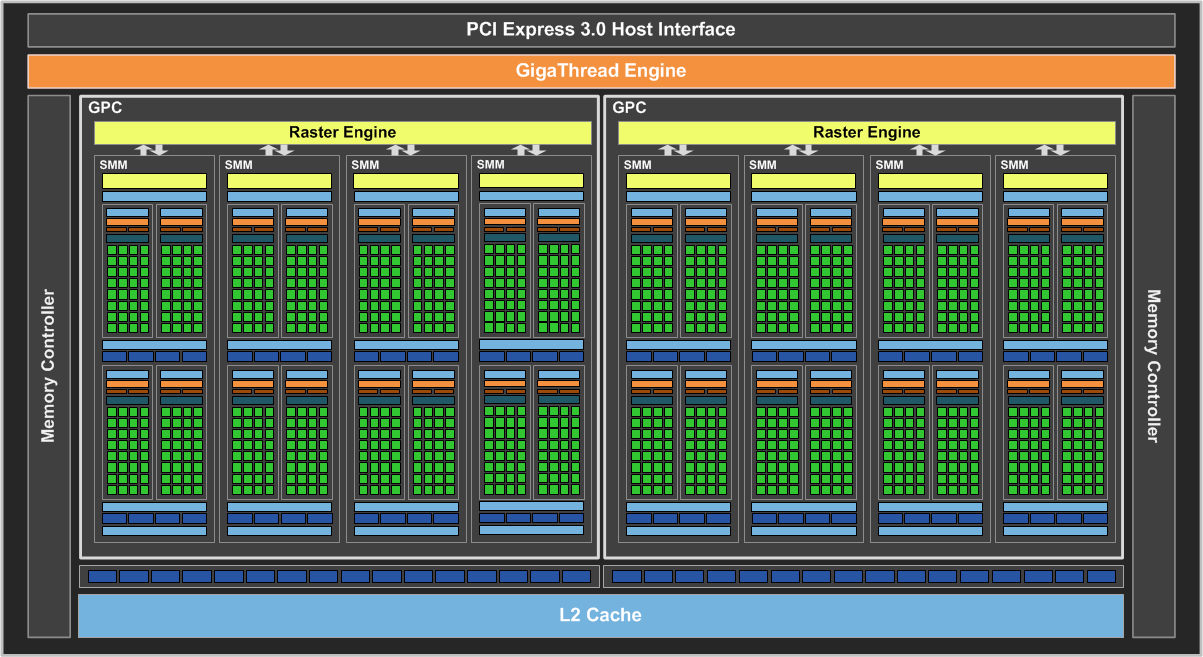
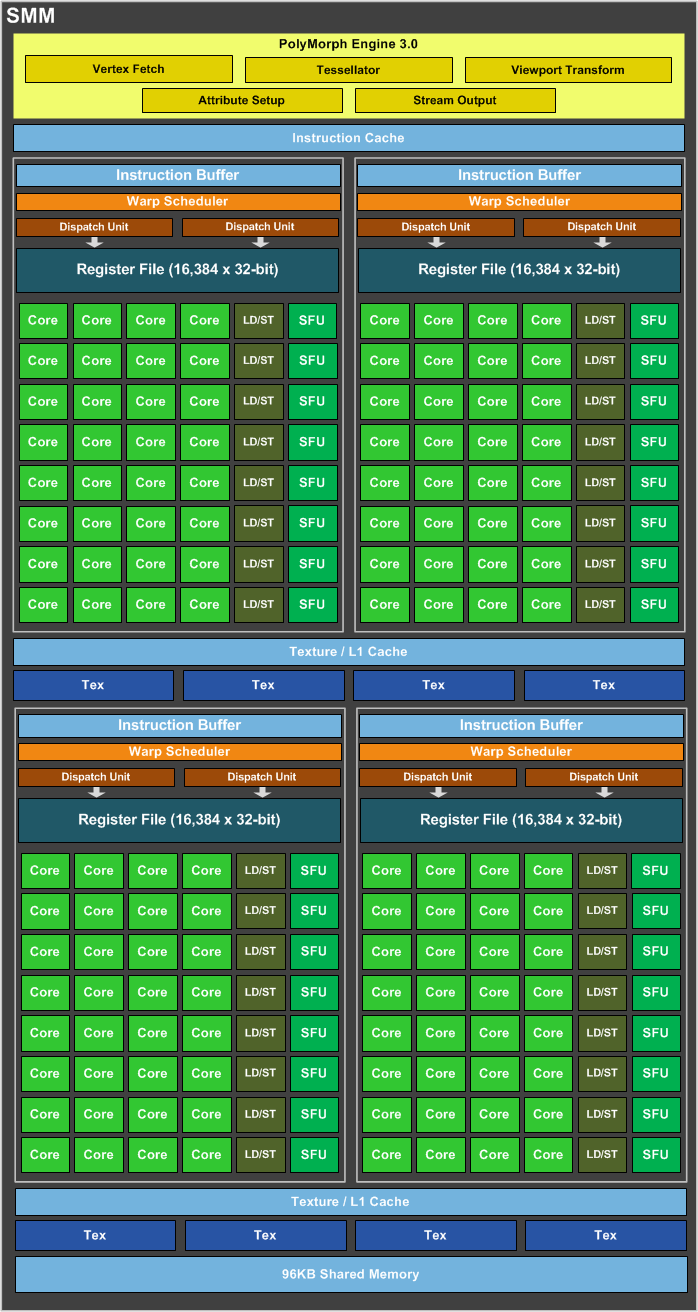
Memory Subsystem
The memory subsystem of GM206 has also been revamped. Nvidia’s third-generation delta color compression engine offers new modes for color compression, allowing the GPU to use its available memory bandwidth more effectively. When combined with the aforementioned caching improvements in the Maxwell SM, GM206 uses roughly 25% fewer bytes per frame compared to prior generation Kepler GPUs. This means that from the perspective of the GPU core, a Kepler-style memory system running at 9.3Gbps would provide effective bandwidth similar to the bandwidth that Maxwell’s enhanced memory system provides.
The memory subsystem of GeForce GTX 960 consists of two 64-bit memory controllers (128-bit) with 2GB of GDDR5 memory. The 128-bit, 7Gbps memory interface is able to effectively provide slightly more bandwidth than its direct predecessor (148.8GB/sec effective in GTX 960 vs 144.2GB/sec in GTX 660).
EVGA decided to add a bit of value to the GTX 960 with a custom design and generous factory overclock.
It is important to note that EVGA sells several custom designed GTX 960 cards, with different coolers. The new Active Cooling Xtreme (ACX) 2.0+ cooler on the GTX 960 SuperSC card which we tested has a somewhat different heatsink design compared to the GTX 960 Superclocked. SuperSC comes with a higher factory overclock and therefore requires better cooling. The GTX 960 SuperSC looks a lot like the GTX 970 Supersuperclocked (EVGA recently renamed Supersuperclocked to SuperSC), but EVGA redesigned the heatpipe system for the GTX 960 SuperSC.
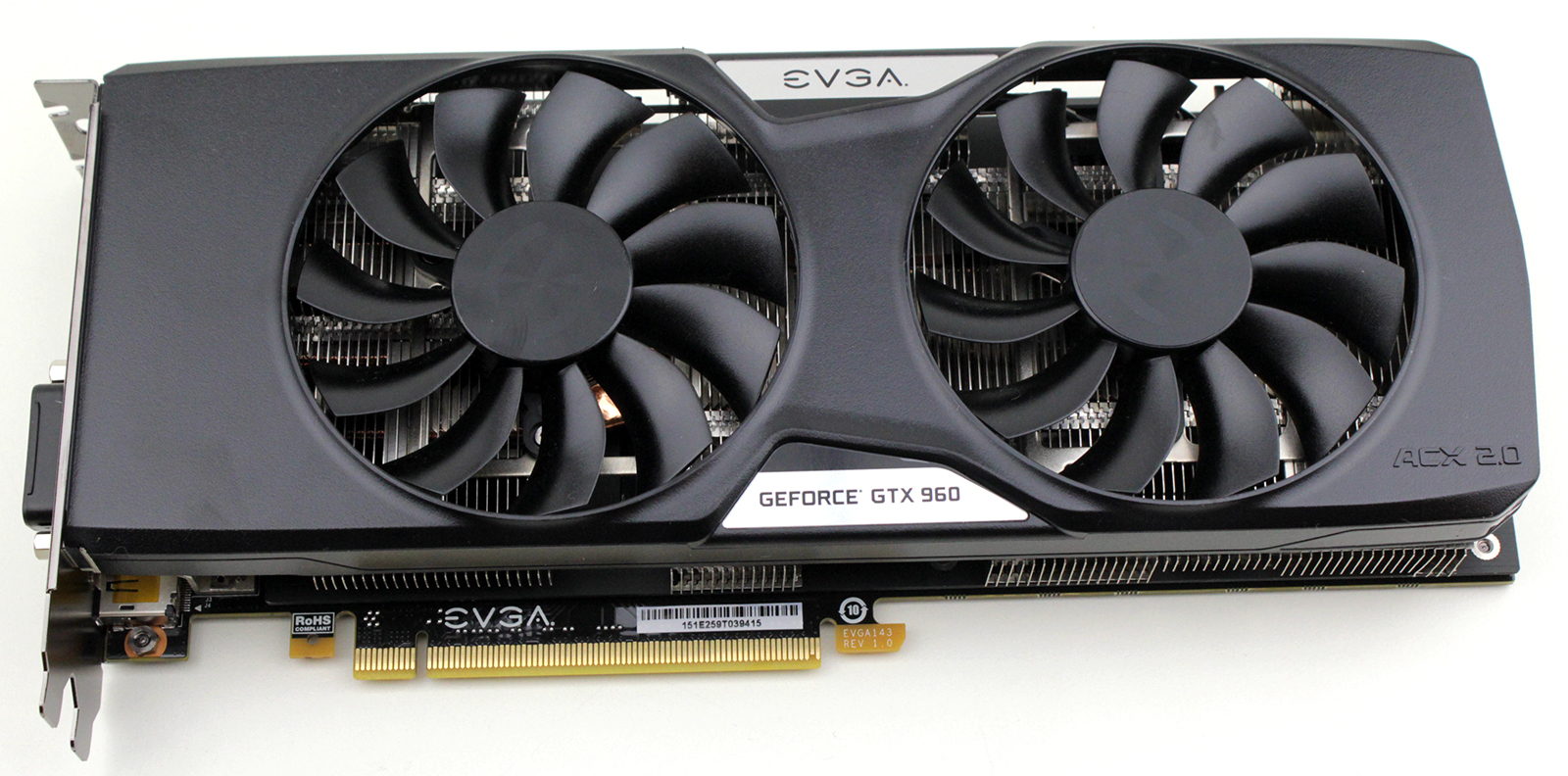 The new shroud looks quite good, but it is plastic just like the old one.
The new shroud looks quite good, but it is plastic just like the old one. 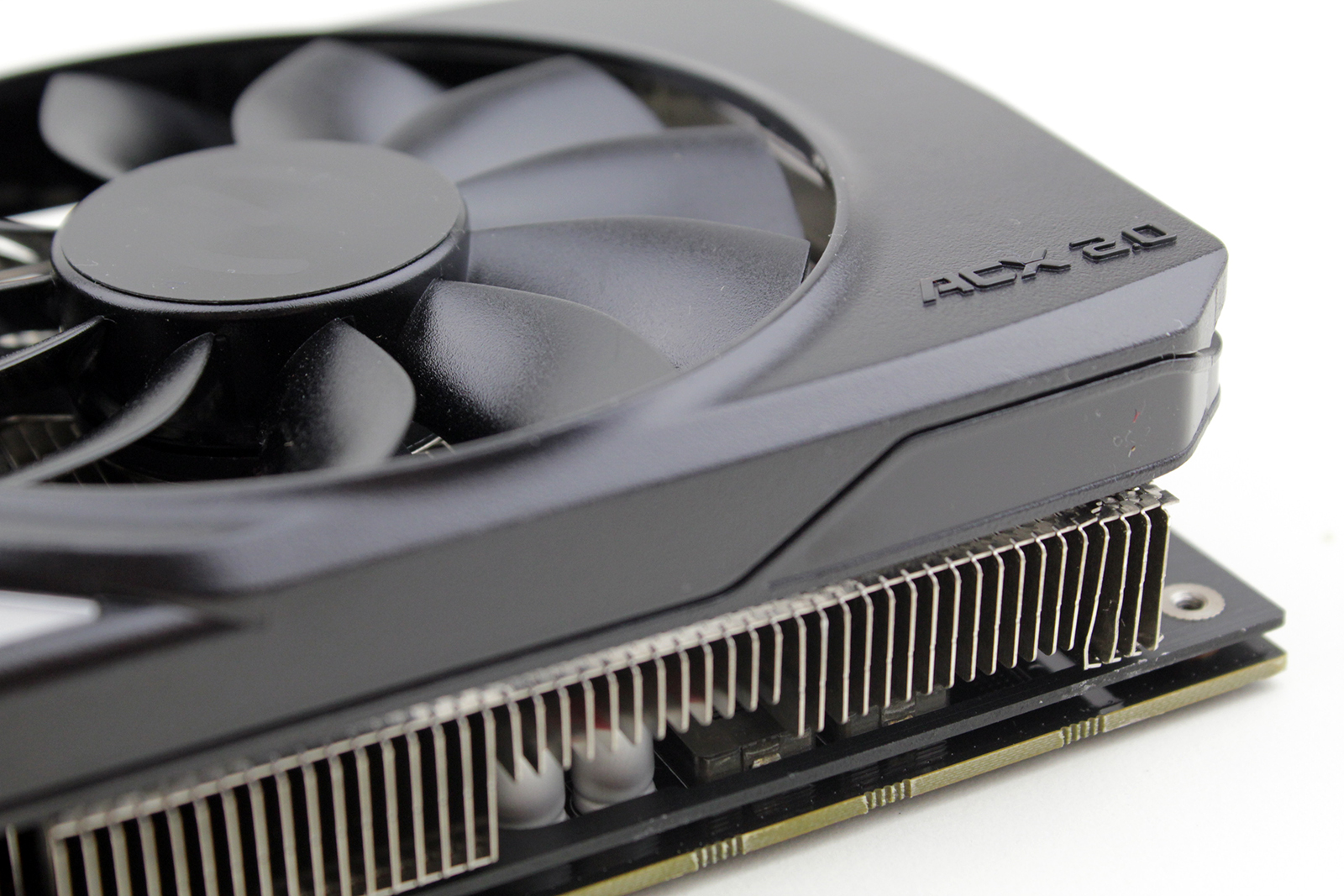
The GTX 960 SuperSC ACX 2.0+ is 25.6cm long and 11.1cm tall. Obviously it is a dual-slot design, but it is somewhat smaller than its high-end predecessors. The ACX cooler on the GTX 780 Superclocked ACX was 27cm long.
The GeForce GTX 960 reference board measures 9.5in or 22cm in length. 
With the ACX/ACX 2.0, EVGA designed a special heatsink with a lot of dissipation surfaces. To maximize dissipation volume, EVGA used a few tricks, such as tall fins at the sides of the cooler. The heatsink was designed in such a way to minimize airflow turbulence between the fans, with clever barriers directing the airflow. Also the GTX 960 SuperSC’s PCB is elongated to match the full length of the ACX 2.0+ heatsink.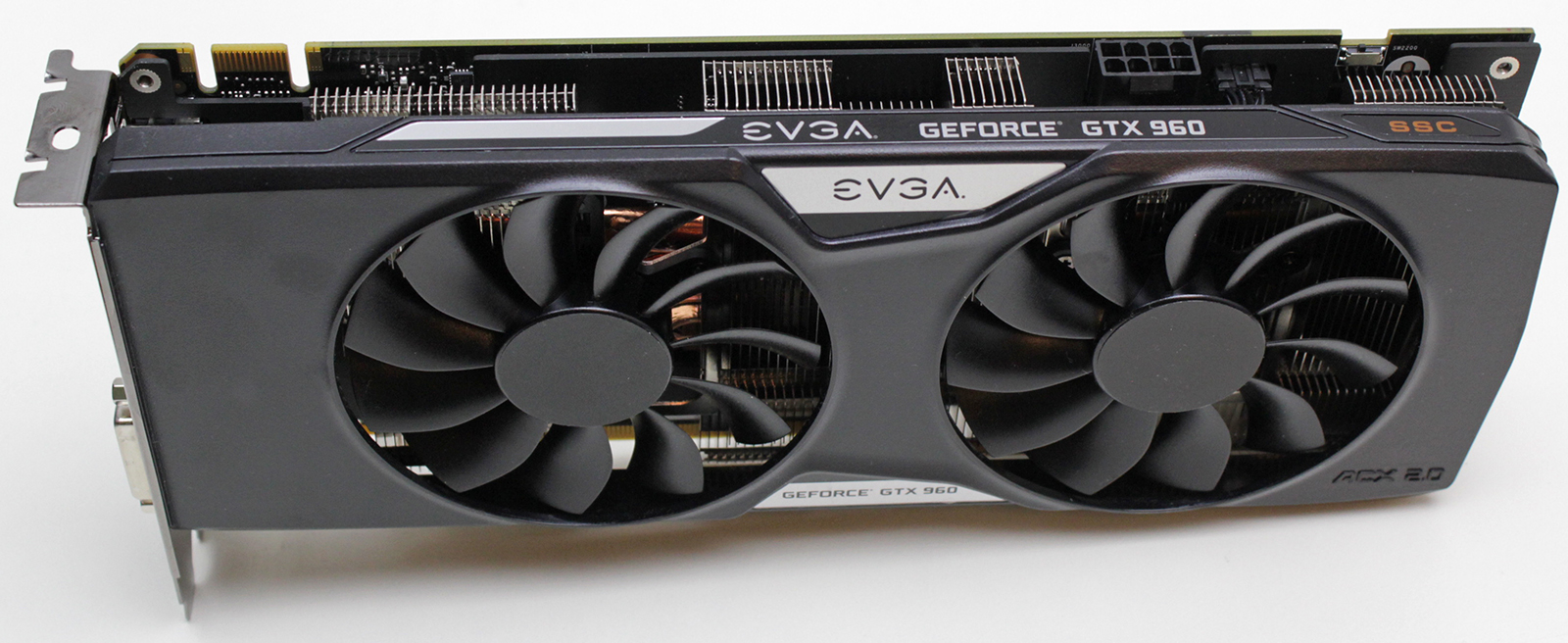
A 6+6 pin power connector setup is used on the GTX 980 and GTX 970, but the reference GTX 960 requires only one 6-pin power connector. EVGA provides more juice to the GTX 960 SuperSC by using one 8-pin power connector and a 6+2 power phase design. The GTX 780, GTX 780 Ti and Titan have a TDP of 250W, compared to the GTX 980 with a 165W TDP, GTX 970 with a 145W TDP and GTX 960 with 120W.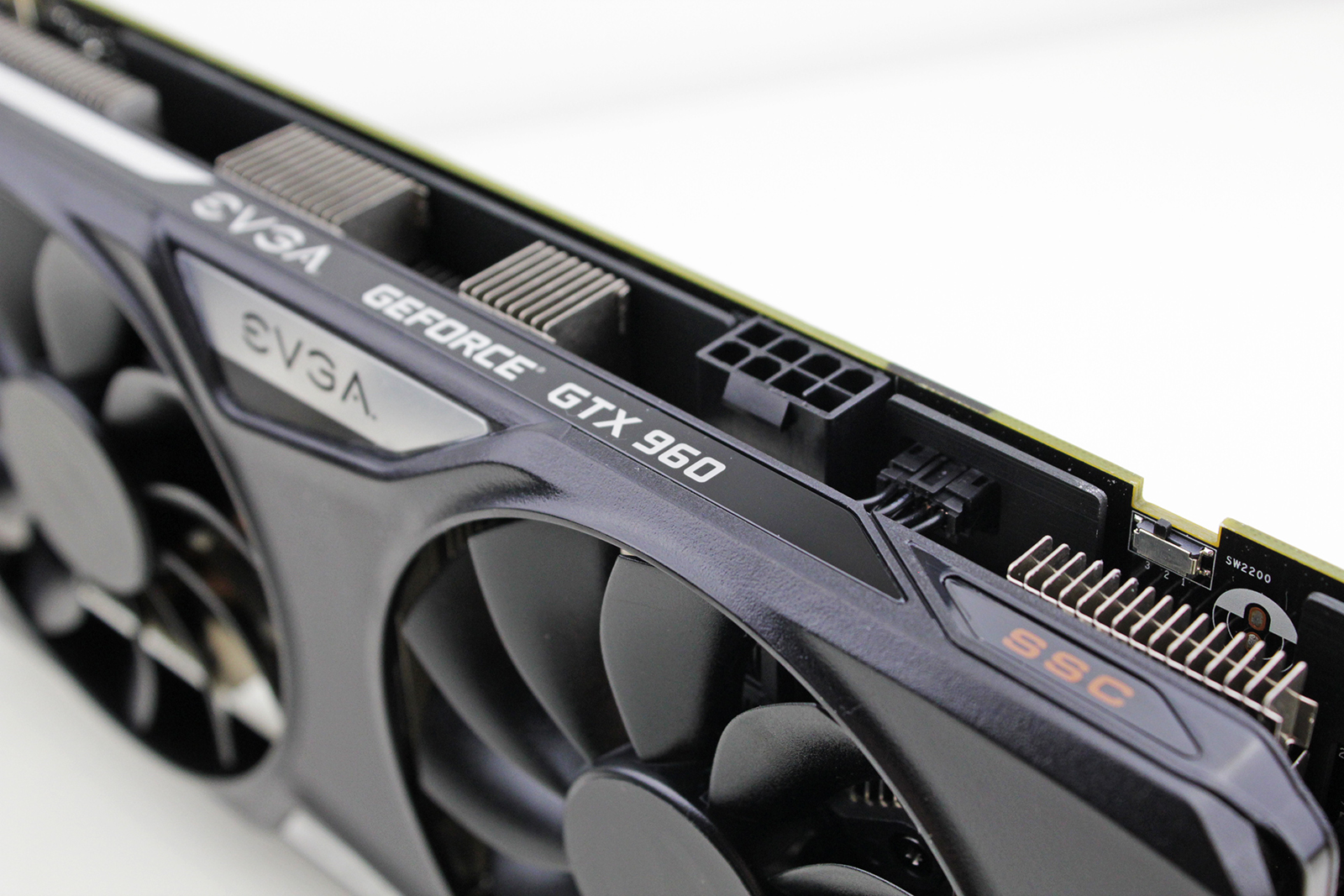
This card is meant for overclocking and QSD (Quick Switch Dual BIOS) allows you to switch to the secondary BIOS with the flick of a switch. The BIOS switch is located close to the PCI power connector.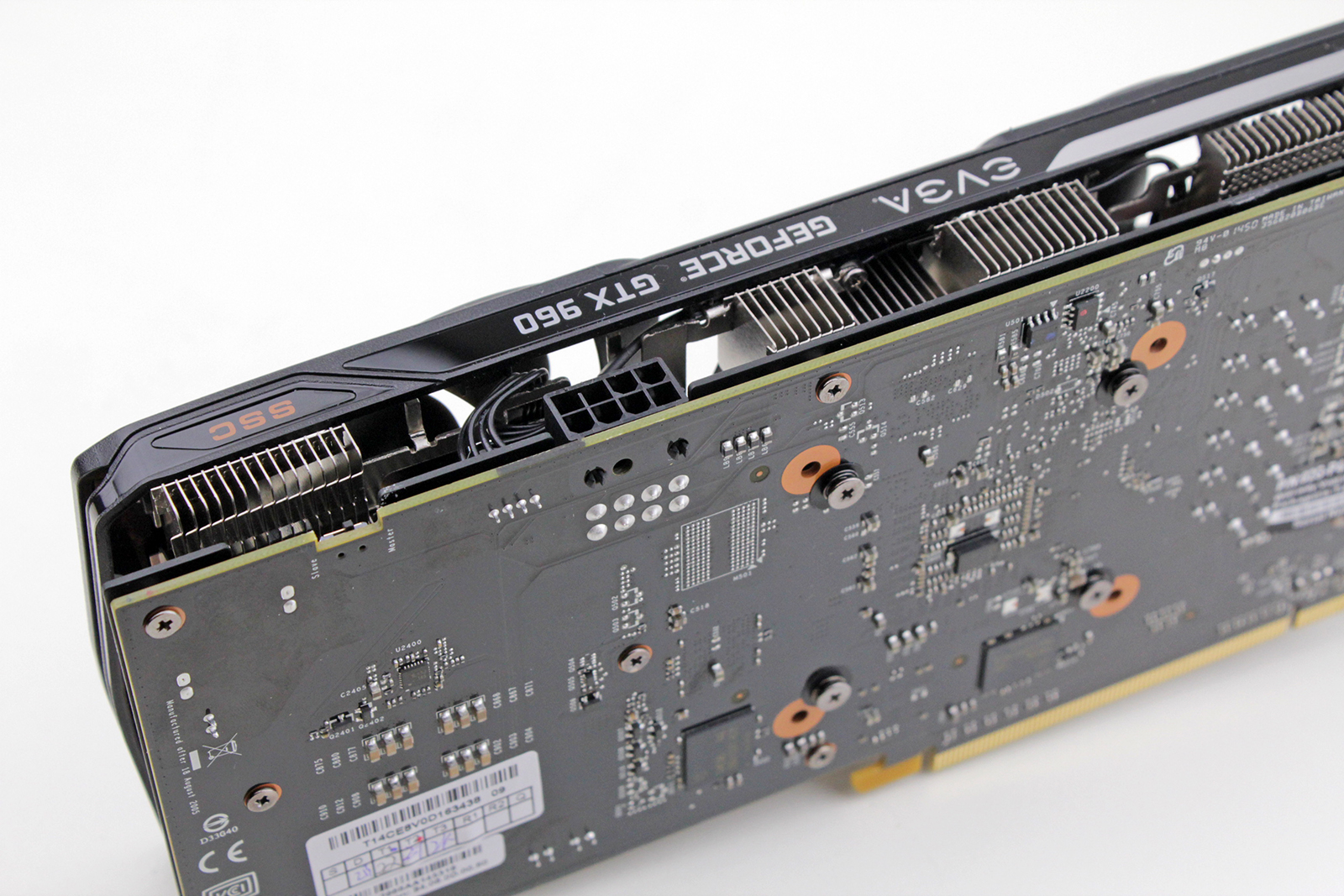
The new fans are said to be more efficient thanks to a new motor. They can hit higher speeds, while the fan blades are designed to deliver more airflow at lower revolutions. Poor fans are often the weakest link in cooler design and EVGA is fully aware of this fact. That is why the company put a lot of effort into tweaking its fans.
The first ACX cooler (used on the GTX 780 Superclocked) has 9-blades, but now EVGA uses an 11-blade fan design. The blades are swept and the fan uses a double ball bearing design. The noise generated by ball bearing designs tends to be very low, at least while they are new. However, since this fan uses two ball bearings it should last a bit longer and generate a less noise even after a couple of years of wear. EVGA’s GTX 960 SuperSC ACX 2.0+ fan turns off below 60C, generating 0dB of noise.
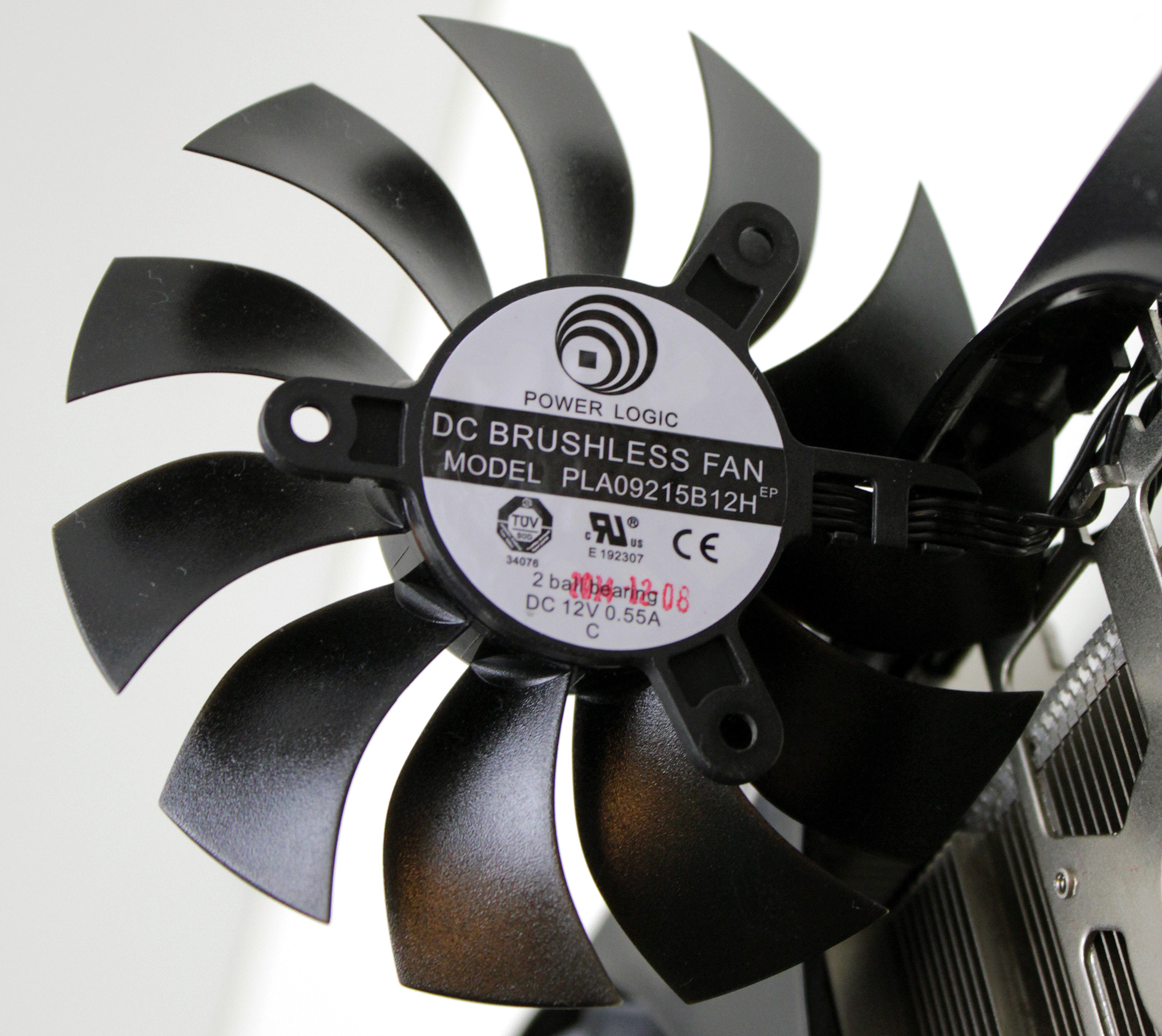
The company even made some promotional materials about the new design.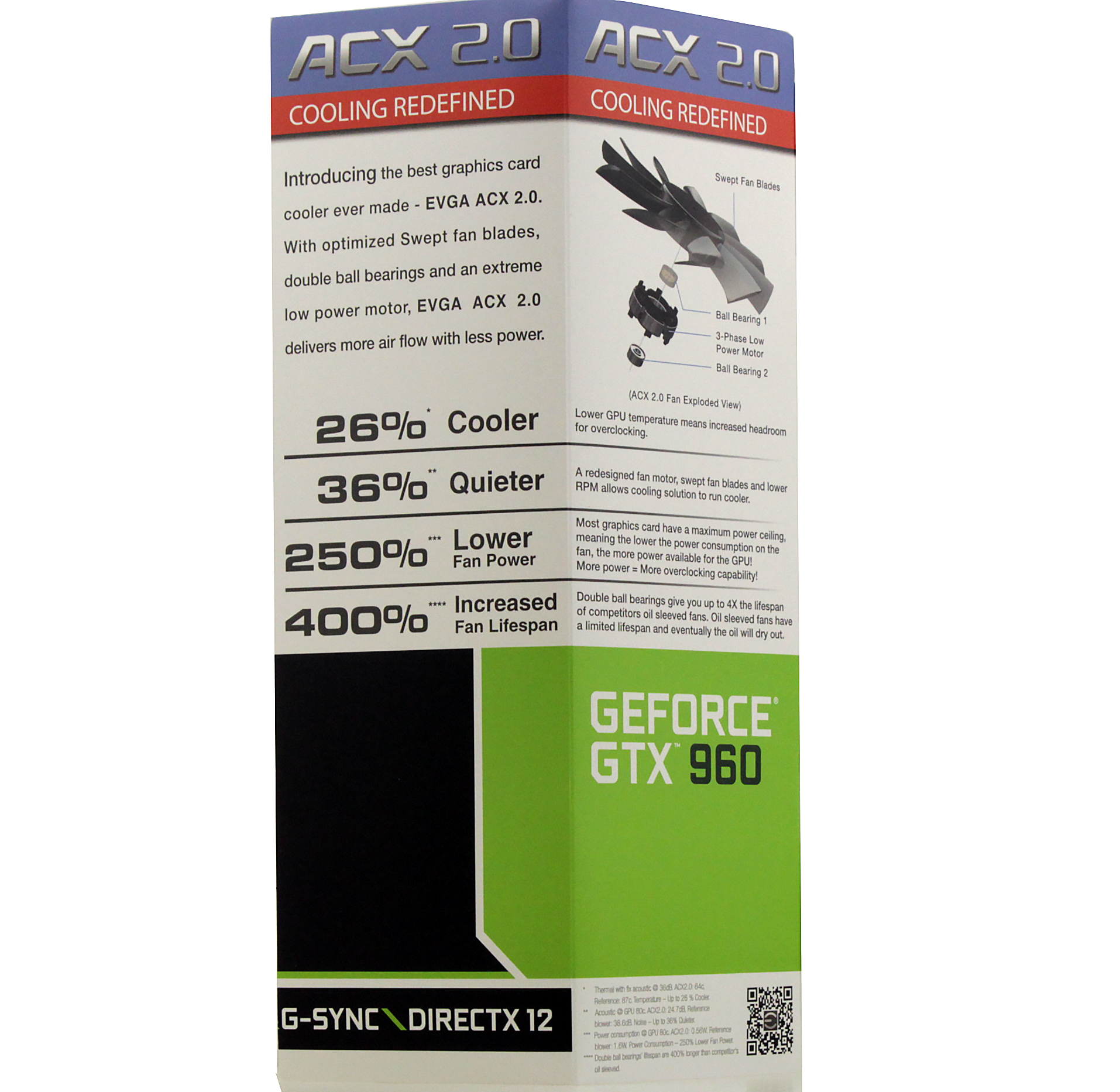
The GTX 960 SuperSC is built for standard dual-SLI, as it features just one SLI connector. The fact that this is a dual-slot design also helps.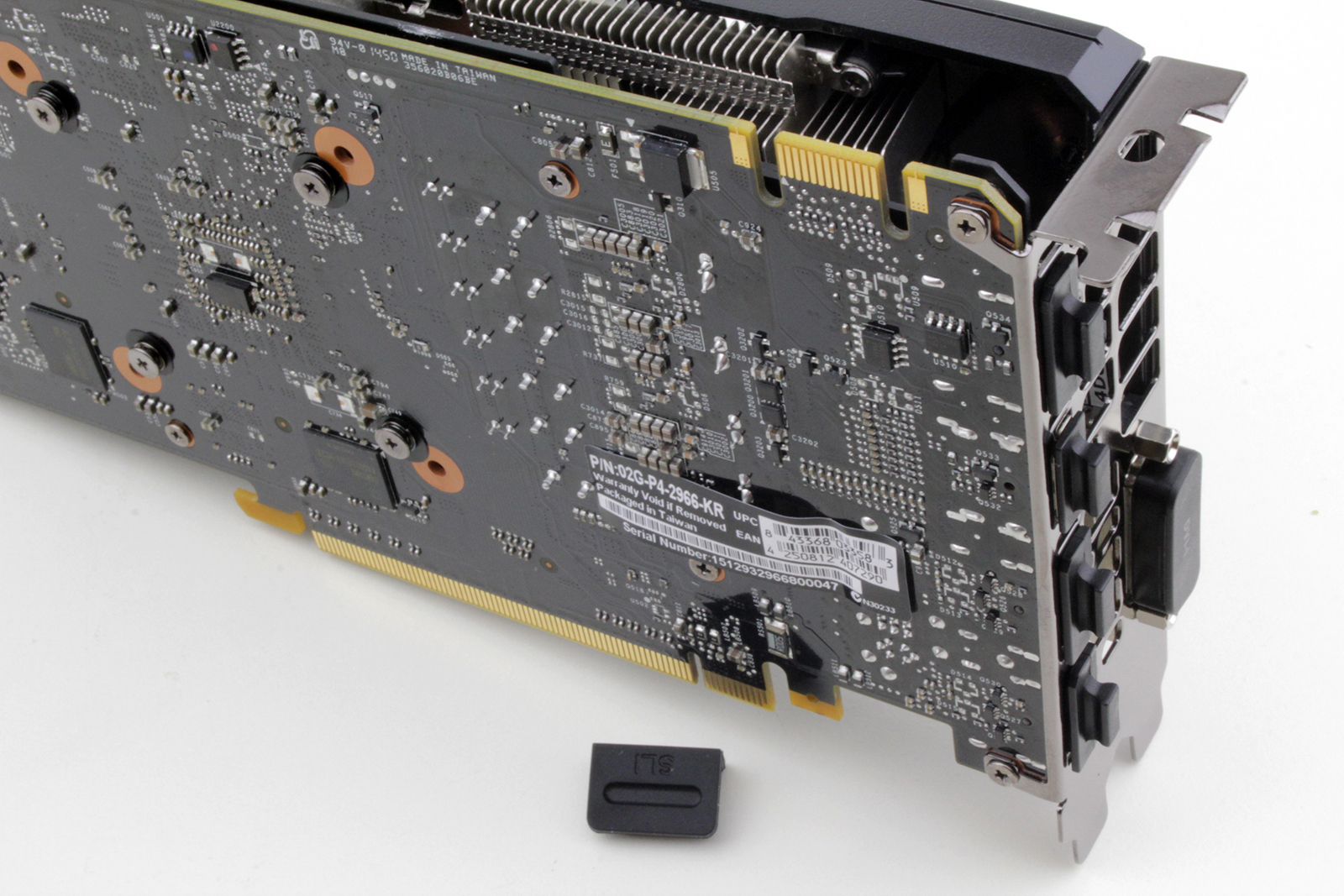
The GTX 960 SuperSC ACX 2.0+ features one standard HDMI connector (2.0 compatible, which includes HD audio and Blu-ray 3D movies support), one dual-link DVI, and three DisplayPort outs. GM206 features support for H.265 (HEVC) encoding and decoding. Four video outs can be used at the same time, just like on the reference GTX 960 card (the reference card provides the same mix of video connectors). Protective caps are on all video out connectors.
The I/O bracket also doubles as an exhaust vent, helping reduce temperatures in the chassis.
The exhaust vent is much more important on the reference cooler which uses a blower style fan (image below).
The GTX 960 SuperSC ACX 2.0+ has 2GB of memory, and two of four memory modules are placed on the back side of the PCB. 
The Samsung chips, (modelK4G41325FC-HC28 which is also used on the GTX 970 SSC) are specified to run at 1750 MHz (7000 MHz GDDR5 effective).
A full-size cooling plate makes direct contact with the memory chips and MOSFETS, reducing memory temperatures by up to 9°C and MOSFETs up to 11°C. 
EVGA designed Straight Heat Pipes (SHP) to reduce the GPU temperature by an additional 5°C. Acording to EVGA internal testing, the triple 8mm straight heat pipes offer 6% better heat dissipation than bent heat pipes with reduced thermal resistance. A big copper base covers the relatively small GM206 GPU.
GTX 960 SuperSC has one 8-pin power connector and a 6+2 power phase design.
The GeForce GTX 960 has been designed to deliver a great 1080p gaming experience with the graphics settings cranked up and FXAA, MFAA, or 4xAA enabled. The GeForce GTX 960 will even deliver playable frame rates with 4K DSR when playing MOBA games like League of Legends. 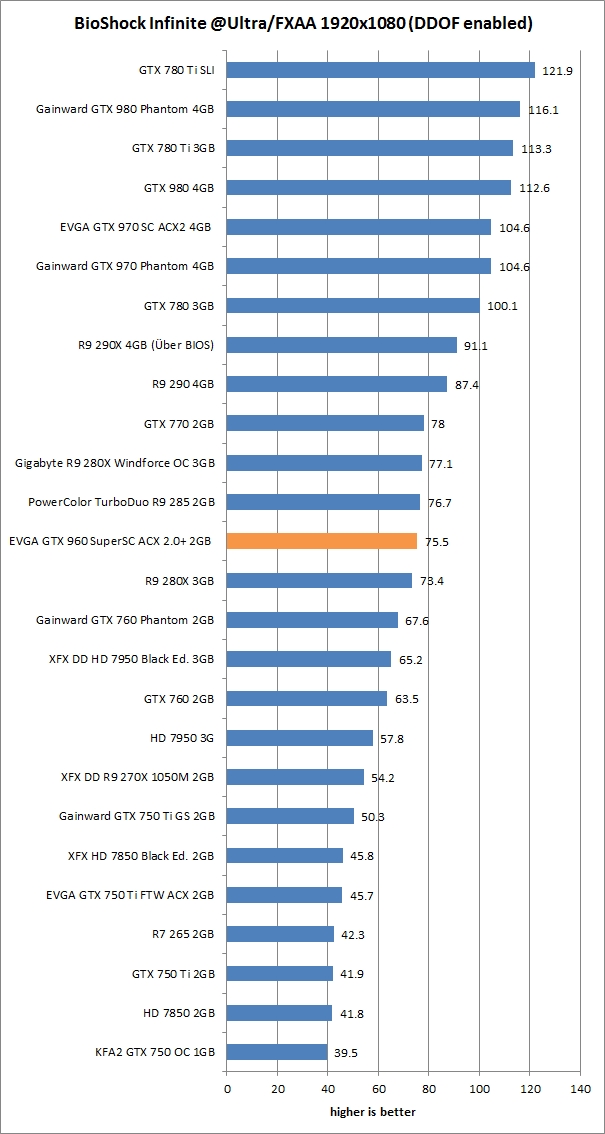
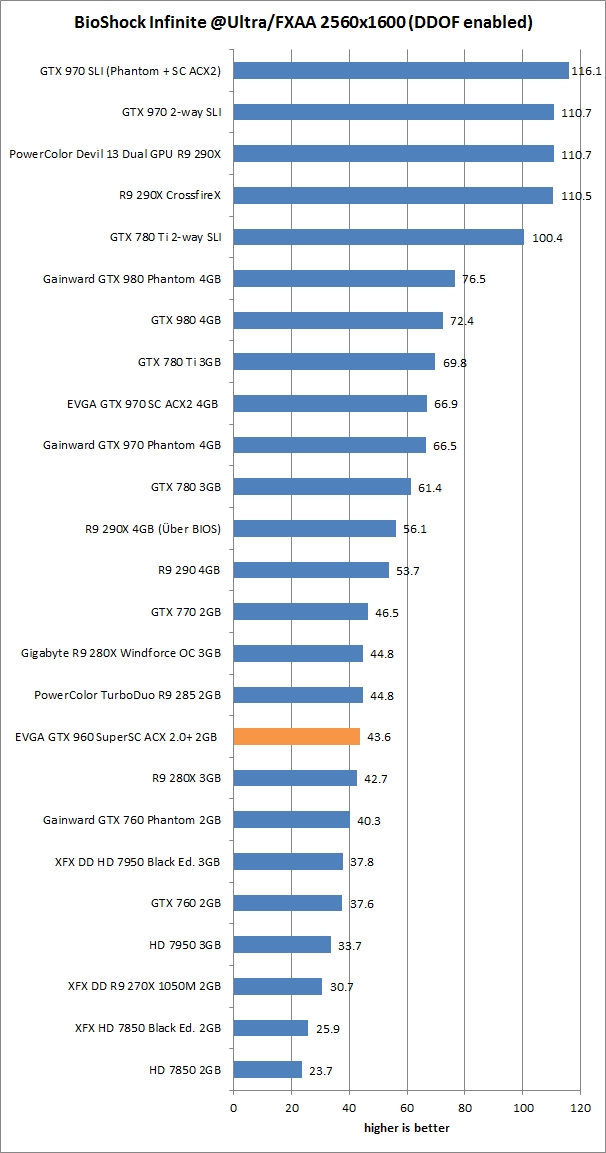
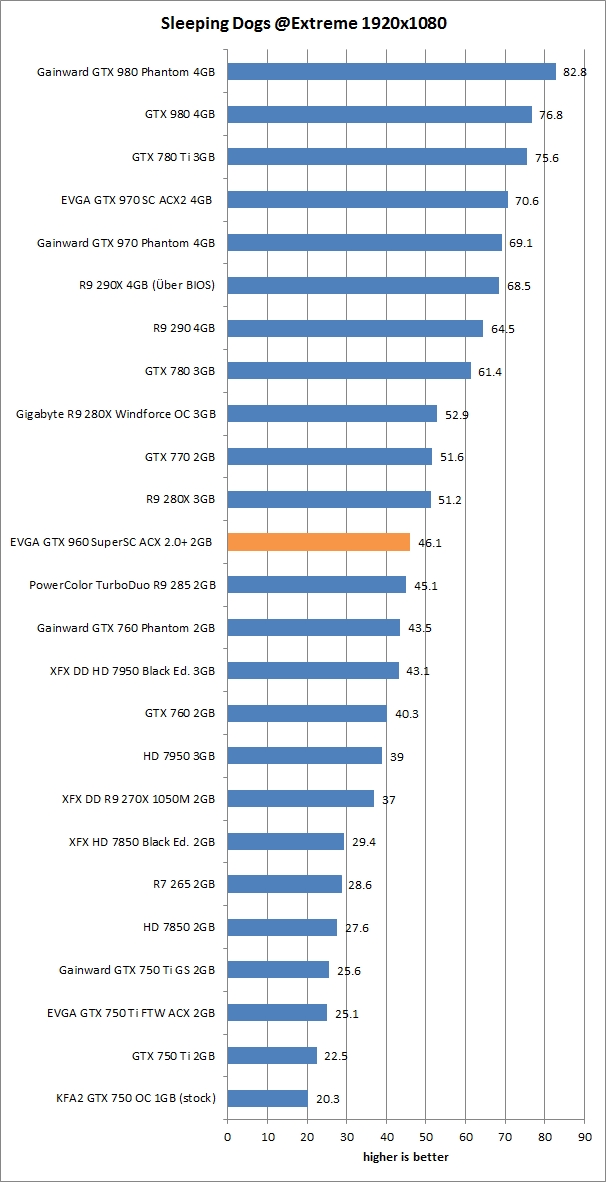
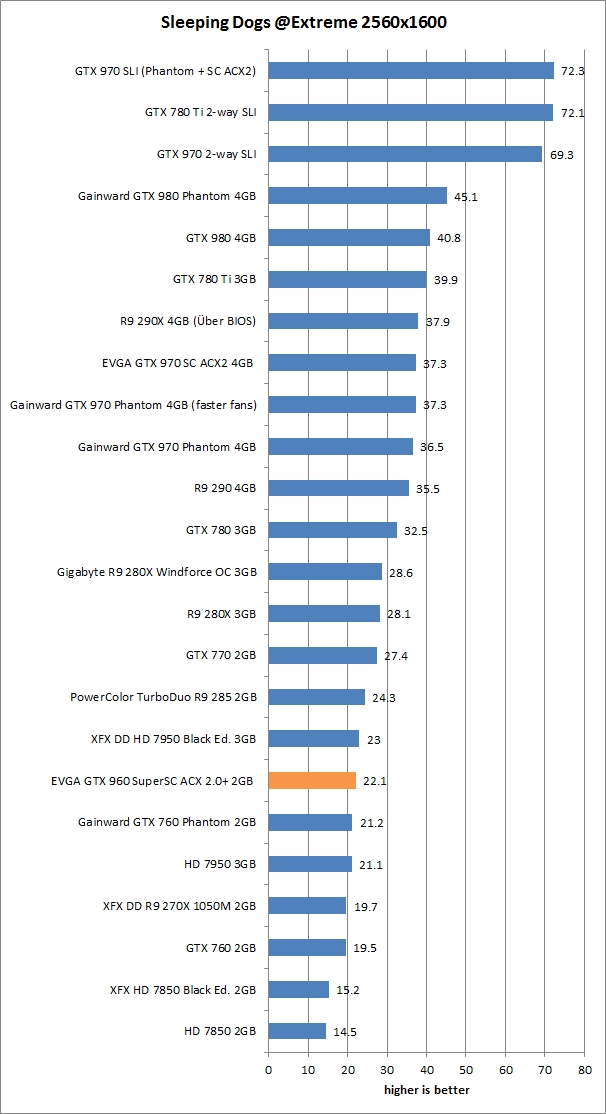
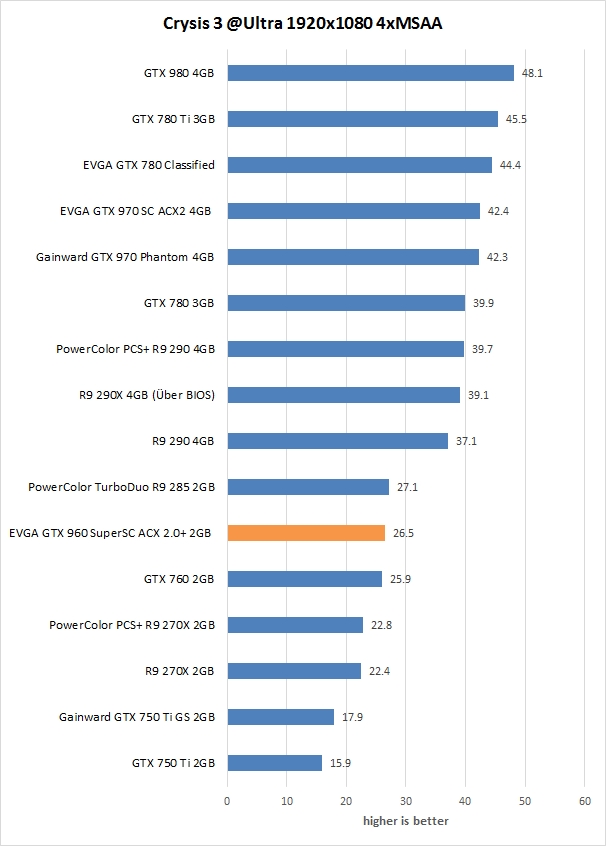
In Futuremark tests, the GTX 960 SSC managed to beat the GTX 770, but the latter was considerably better in most games.
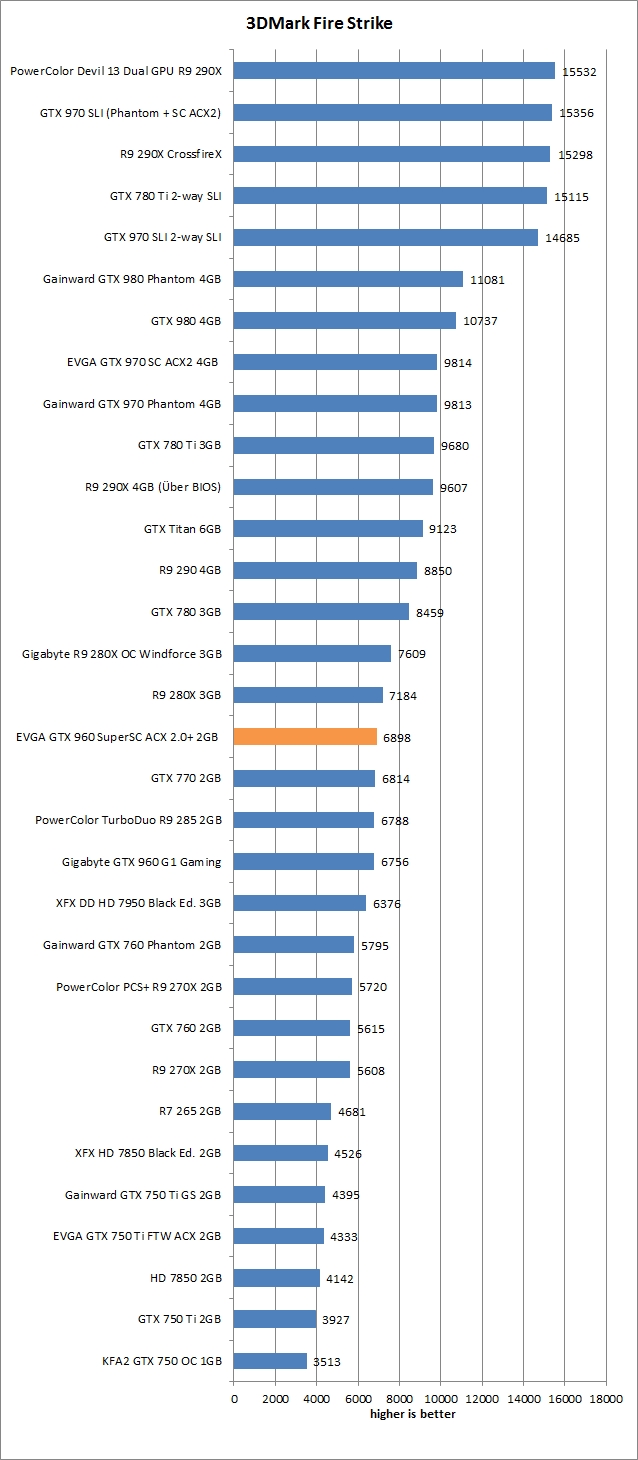
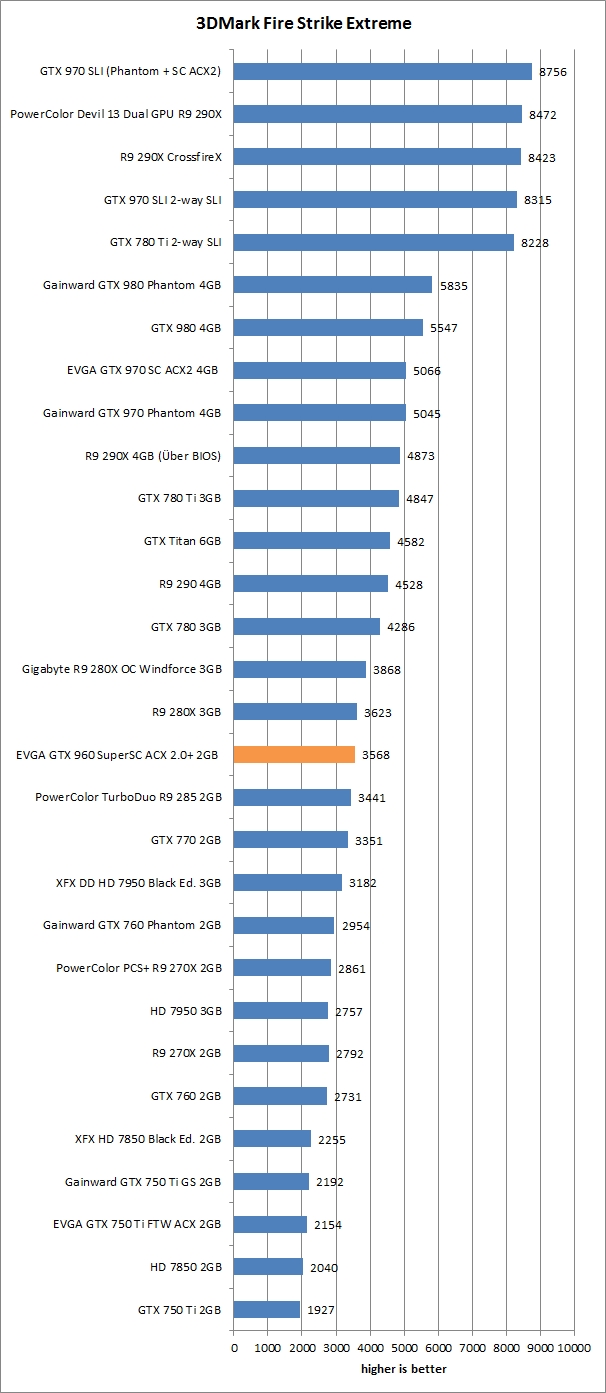
The GTX 960 SuperSC fans are not loud in 3D and this time we can confirm that there is no coil wine like on the GTX 970 Superclocked.
You can use PrecisionX to monitor and control the fan speed. PrecisionX correctly shows info that the fans are not spinning in idle.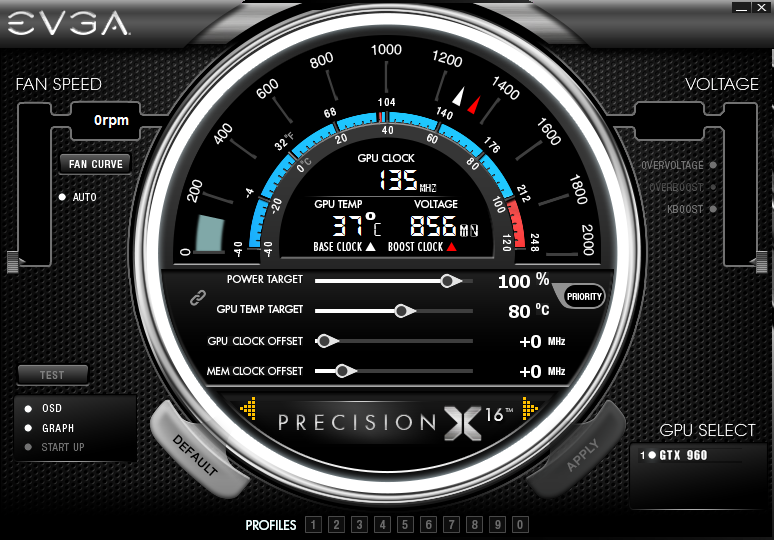
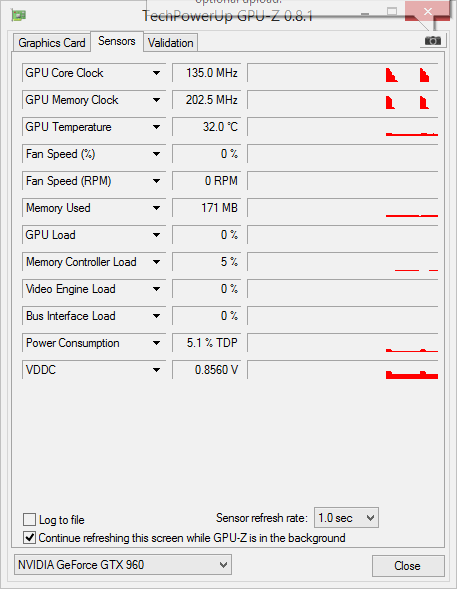
GPUZ idle
Next image shows that the fans start rotating when the GPU temperature reaches 63 Celsius degree.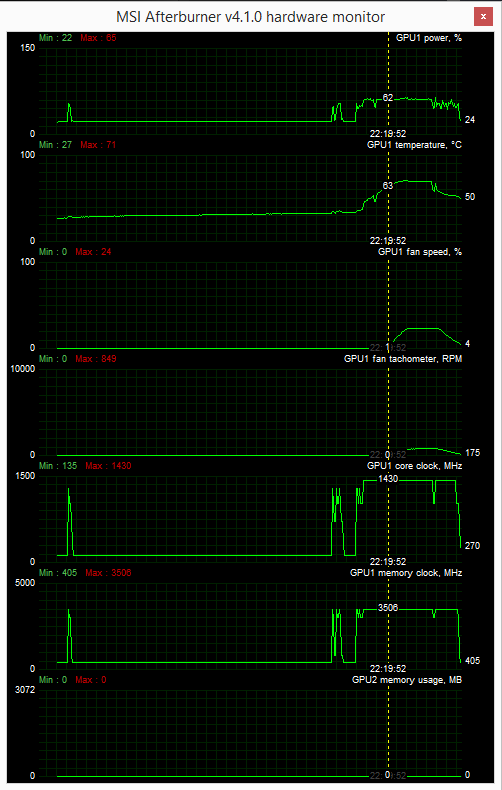
The huge heatsink with three fans is able to keep the temperature below 75 Celsius degree despite the GPU is factory highly overclocked. Note that fan speed is only 31% RPM, and the card is silent.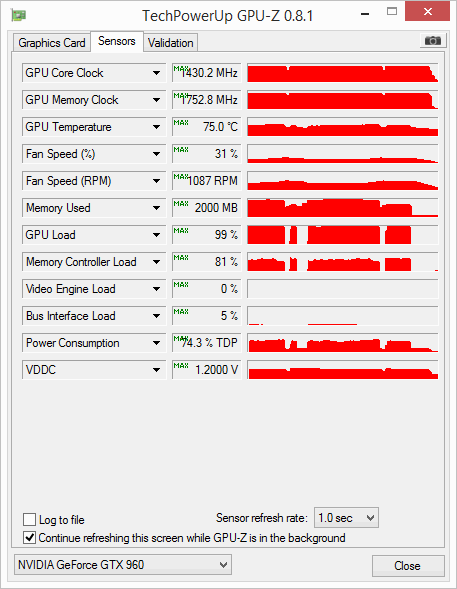
The Geforce GTX 960 has a fair amount of overclocking headroom. The reference card’s base clock frequency is 1126MHz, with a boost clock of 1178MHz. However, The EVGA GTX 960 SSC base clock frequency is 1279MHz, with a boost clock of 1342MHz.
During our OC tests, the EVGA GTX 960 SSC was able to hit speeds of 1500MHz with ease: no voltage modifications are necessary to achieve this.
However, to get to 1500MHz we had to manually increase the fan RPM to 55%. This was enough to keep the GPU temperature below 61 degrees Celsius at a Boost clock of up to 1529MHz.
Memory overclocking yielded good results. We increased the clock by 450MHz with no adverse effects. 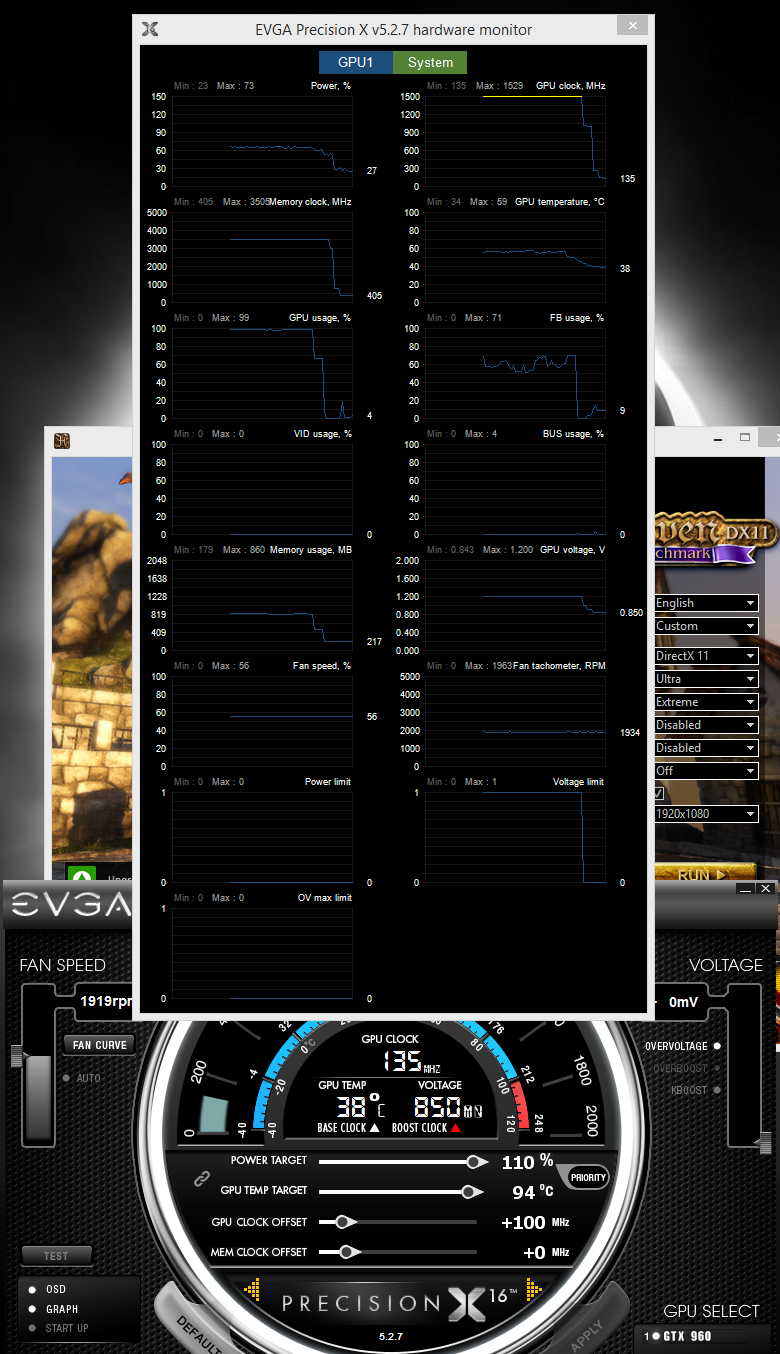
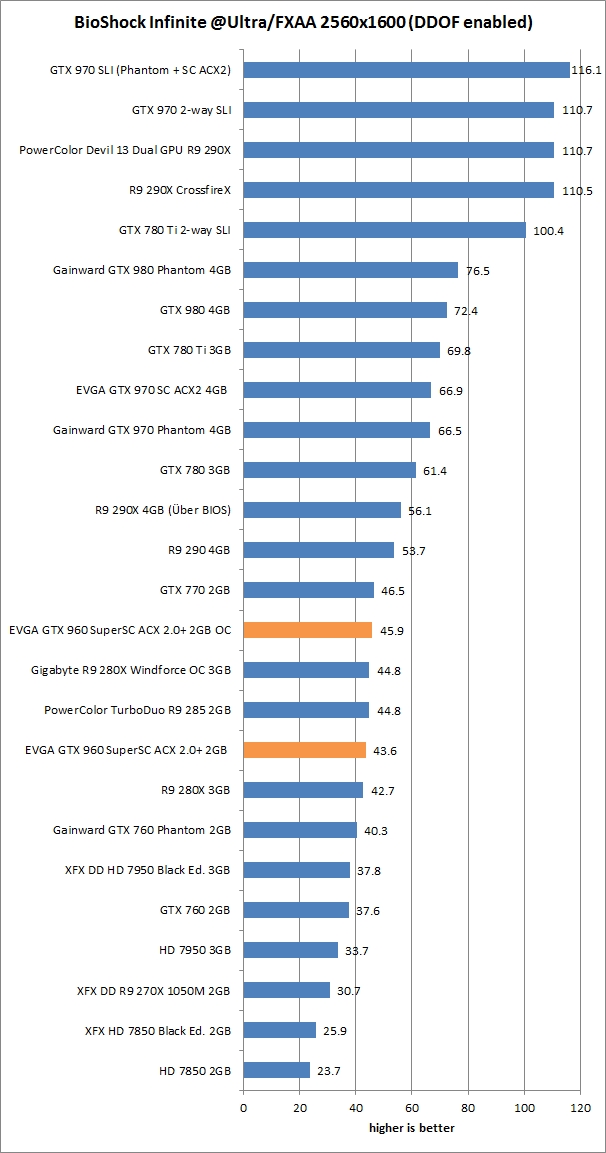
The GTX 980, GTX 970, and GTX 960 do not bring a huge performance boost compared to the previous generation, but they prove Maxwell is vastly more efficient than Kepler. The GTX 980 has a TDP of just 165W, GTX 970 has a TDP of just 145W, and GTX 960 has TDP of just 120W. EVGA GTX 960 SuperSC card is factory overclocked (153MHz for the GPU) and this increases power consumption. We do not have reference card so we don’t know the exact difference in real-life conditions, but as you can see form the table, our total PC consumption was just 256W and this is great considering the gaming performance this card offers.
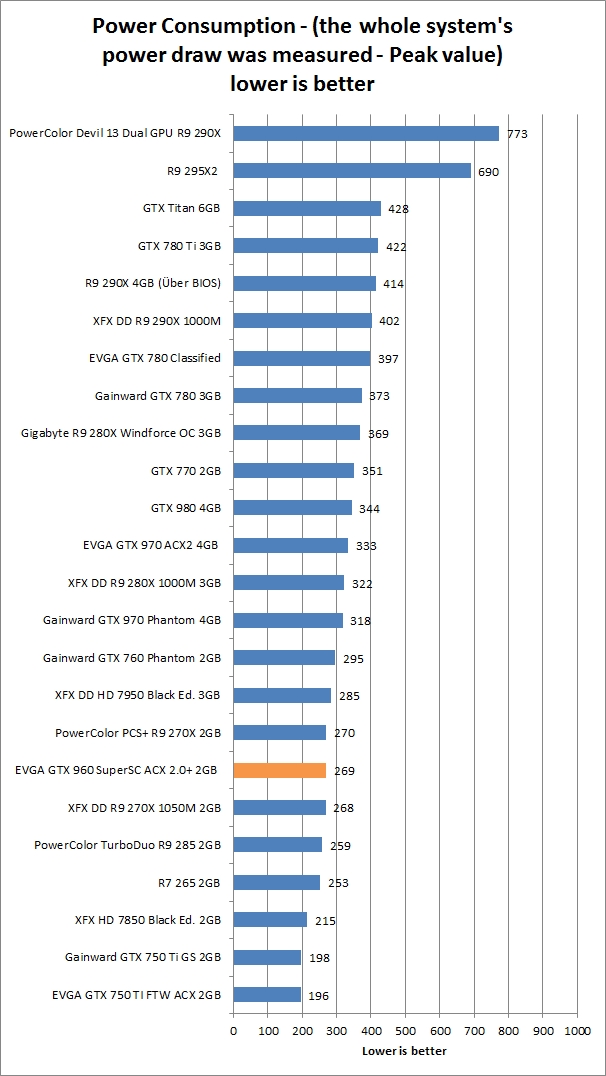
Today we looked at the EVGA GTX 960 SSC 2GB graphics card which comes with a hefty 153MHz factory overclock that raises GPU base frequency from 1126MHz to 1279MHz. All GTX 960 boards launched today ship with 2GB of memory, and all Nvidia board partners decided to offer a wide range of GTX 960 cards using their own custom board designs on launch day. EVGA showed four different GTX 960 cards.
EVGA is not only Nvidia partner to offer factory overclocked Geforce GTX 960 boards, with clock speeds in excess of 1300MHz. In order to offer a unique and more competitive product, EVGA decided to use the redesigned ACX 2.0+ cooler, along with a custom PCB design, 6+2 power design and 8-pin power connector. All this adds up to a very good overclocking platform. Therefore we were able to increase the clock and GTX 960 SuperSC was able to hit speeds of 1529MHz.
We did not increase voltages, but this can be done using the PrecisionX tool. Should you choose to increase the voltage, you can look forward to even higher clocks. The memory was also eager to play ball and we ended up with an effortless 450MHz overclock.
The EVGA GTX 960 SSC provides a good combination of performance, price, and power efficiency. The GeForce GTX 960 has been designed to deliver a great 1080p gaming experience with the graphics settings cranked up and FXAA, MFAA, or 4xAA enabled. The GeForce GTX 960 will even deliver playable frame rates with 4K DSR when playing MOBA games like League of Legends.
In stock form, the GeForce GTX 960 is 50% faster than the GeForce GTX 660, making it a tremendous upgrade for gamers who haven’t upgraded their card in more than two years. However, the GTX 960 pulls even further away from its predecessor once it’s overclocked. EVGA GTX 960 SSC is great card if you want factory overclocked card or the card that will follow you during additional overclocking, and stay relatively quiet even then.
EVGA GeForce GTX 960 SuperSC ACX 2.0+ should be available immediately with an MSRP of €229.90 in Europe and US $209.99 (exc. VAT) in the USA.


